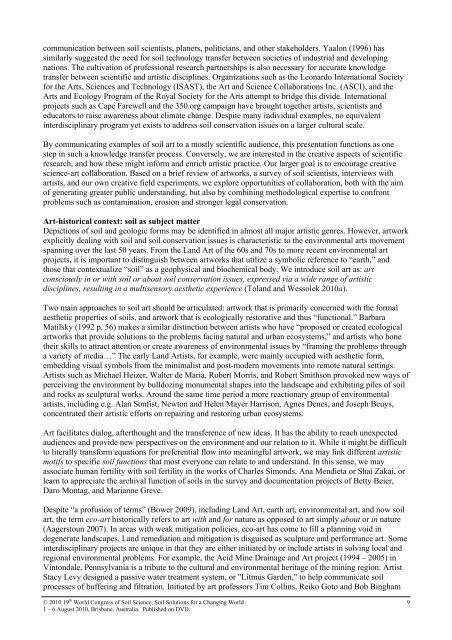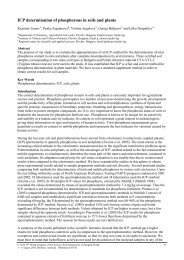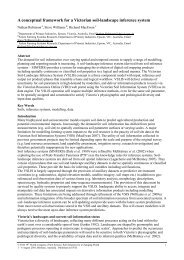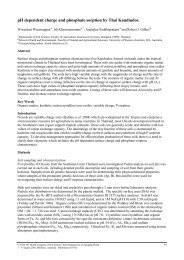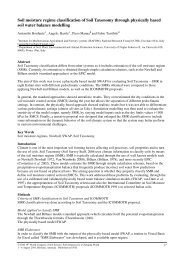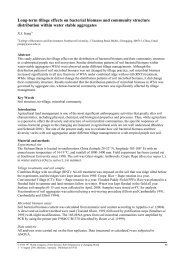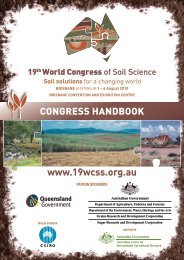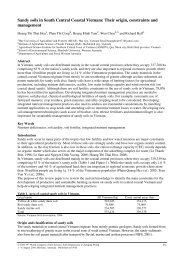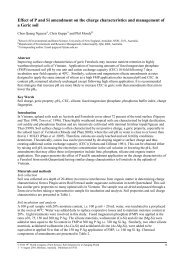Soil art - International Union of Soil Sciences
Soil art - International Union of Soil Sciences
Soil art - International Union of Soil Sciences
Create successful ePaper yourself
Turn your PDF publications into a flip-book with our unique Google optimized e-Paper software.
communication between soil scientists, planers, politicians, and other stakeholders. Yaalon (1996) has<br />
similarly suggested the need for soil technology transfer between societies <strong>of</strong> industrial and developing<br />
nations. The cultivation <strong>of</strong> pr<strong>of</strong>essional research p<strong>art</strong>nerships is also necessary for accurate knowledge<br />
transfer between scientific and <strong>art</strong>istic disciplines. Organizations such as the Leonardo <strong>International</strong> Society<br />
for the Arts, <strong>Sciences</strong> and Technology (ISAST), the Art and Science Collaborations Inc. (ASCI), and the<br />
Arts and Ecology Program <strong>of</strong> the Royal Society for the Arts attempt to bridge this divide. <strong>International</strong><br />
projects such as Cape Farewell and the 350.org campaign have brought together <strong>art</strong>ists, scientists and<br />
educators to raise awareness about climate change. Despite many individual examples, no equivalent<br />
interdisciplinary program yet exists to address soil conservation issues on a larger cultural scale.<br />
By communicating examples <strong>of</strong> soil <strong>art</strong> to a mostly scientific audience, this presentation functions as one<br />
step in such a knowledge transfer process. Conversely, we are interested in the creative aspects <strong>of</strong> scientific<br />
research, and how these might inform and enrich <strong>art</strong>istic practice. Our larger goal is to encourage creative<br />
science-<strong>art</strong> collaboration. Based on a brief review <strong>of</strong> <strong>art</strong>works, a survey <strong>of</strong> soil scientists, interviews with<br />
<strong>art</strong>ists, and our own creative field experiments, we explore opportunities <strong>of</strong> collaboration, both with the aim<br />
<strong>of</strong> generating greater public understanding, but also by combining methodological expertise to confront<br />
problems such as contamination, erosion and stronger legal conservation.<br />
Art-historical context: soil as subject matter<br />
Depictions <strong>of</strong> soil and geologic forms may be identified in almost all major <strong>art</strong>istic genres. However, <strong>art</strong>work<br />
explicitly dealing with soil and soil conservation issues is characteristic to the environmental <strong>art</strong>s movement<br />
spanning over the last 50 years. From the Land Art <strong>of</strong> the 60s and 70s to more recent environmental <strong>art</strong><br />
projects, it is important to distinguish between <strong>art</strong>works that utilize a symbolic reference to “e<strong>art</strong>h,” and<br />
those that contextualize “soil” as a geophysical and biochemical body. We introduce soil <strong>art</strong> as: <strong>art</strong><br />
consciously in or with soil or about soil conservation issues, expressed via a wide range <strong>of</strong> <strong>art</strong>istic<br />
disciplines, resulting in a multisensory aesthetic experience (Toland and Wessolek 2010a).<br />
Two main approaches to soil <strong>art</strong> should be <strong>art</strong>iculated: <strong>art</strong>work that is primarily concerned with the formal<br />
aesthetic properties <strong>of</strong> soils, and <strong>art</strong>work that is ecologically restorative and thus “functional.” Barbara<br />
Matilsky (1992 p. 56) makes a similar distinction between <strong>art</strong>ists who have “proposed or created ecological<br />
<strong>art</strong>works that provide solutions to the problems facing natural and urban ecosystems,” and <strong>art</strong>ists who hone<br />
their skills to attract attention or create awareness <strong>of</strong> environmental issues by “framing the problems through<br />
a variety <strong>of</strong> media…” The early Land Artists, for example, were mainly occupied with aesthetic form,<br />
embedding visual symbols from the minimalist and post-modern movements into remote natural settings.<br />
Artists such as Michael Heizer, Walter de Maria, Robert Morris, and Robert Smithson provoked new ways <strong>of</strong><br />
perceiving the environment by bulldozing monumental shapes into the landscape and exhibiting piles <strong>of</strong> soil<br />
and rocks as sculptural works. Around the same time period a more reactionary group <strong>of</strong> environmental<br />
<strong>art</strong>ists, including e.g. Alan Sonfist, Newton and Helen Mayer Harrison, Agnes Denes, and Joseph Beuys,<br />
concentrated their <strong>art</strong>istic efforts on repairing and restoring urban ecosystems.<br />
Art facilitates dialog, afterthought and the transference <strong>of</strong> new ideas. It has the ability to reach unexpected<br />
audiences and provide new perspectives on the environment and our relation to it. While it might be difficult<br />
to literally transform equations for preferential flow into meaningful <strong>art</strong>work, we may link different <strong>art</strong>istic<br />
motifs to specific soil functions that most everyone can relate to and understand. In this sense, we may<br />
associate human fertility with soil fertility in the works <strong>of</strong> Charles Simonds, Ana Mendieta or Shai Zakai, or<br />
learn to appreciate the archival function <strong>of</strong> soils in the survey and documentation projects <strong>of</strong> Betty Beier,<br />
Daro Montag, and Marianne Greve.<br />
Despite “a pr<strong>of</strong>usion <strong>of</strong> terms” (Bower 2009), including Land Art, e<strong>art</strong>h <strong>art</strong>, environmental <strong>art</strong>, and now soil<br />
<strong>art</strong>, the term eco-<strong>art</strong> historically refers to <strong>art</strong> with and for nature as opposed to <strong>art</strong> simply about or in nature<br />
(Aagerstoun 2007). In areas with weak mitigation policies, eco-<strong>art</strong> has come to fill a planning void in<br />
degenerate landscapes. Land remediation and mitigation is disguised as sculpture and performance <strong>art</strong>. Some<br />
interdisciplinary projects are unique in that they are either initiated by or include <strong>art</strong>ists in solving local and<br />
regional environmental problems. For example, the Acid Mine Drainage and Art project (1994 – 2005) in<br />
Vintondale, Pennsylvania is a tribute to the cultural and environmental heritage <strong>of</strong> the mining region. Artist<br />
Stacy Levy designed a passive water treatment system, or "Litmus Garden," to help communicate soil<br />
processes <strong>of</strong> buffering and filtration. Initiated by <strong>art</strong> pr<strong>of</strong>essors Tim Collins, Reiko Goto and Bob Bingham<br />
© 2010 19 th World Congress <strong>of</strong> <strong>Soil</strong> Science, <strong>Soil</strong> Solutions for a Changing World 9<br />
1 – 6 August 2010, Brisbane, Australia. Published on DVD.


